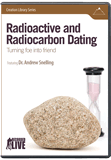How Old Are Rocks?
Rocks Exhibit
on November 28, 2016Absolute ages
The Smithsonian National Museum of Natural History teaches:
Rocks contain atomic clocks. They enable geologists to calculate when a rock formed—its absolute age—by measuring its radioactive elements. At last, geologists were able to attach years to the fossil-based, relative time scale and figure out, for example, exactly when the dinosaurs ruled the Earth. (www.mnh.si.edu/earth/text/3_1_2_3.html)
What the museum may not tell you is that not all rocks contain “atomic clocks.” Instead, igneous (formerly molten) rocks and metamorphic rocks are the best candidates, while sedimentary rocks (which contain fossils) generally lack atomic clocks. There are many problems with this “absolute” method of age-dating rocks, and many assumptions involved with these methods. A major assumption of any radioisotope dating method is that the decay rate of a given isotope (an atomic nucleus with a given number of neutrons) is constant—that it has always been what it is today. Radioisotope methods can only be used to estimate a reliable age if nuclear decay rates have always been constant. After all, a clock would not give the correct time if it were to dramatically speed up or slow down. A group of scientists participating in the RATE (Radioisotopes and the Age of the Earth) project has recently uncovered several lines of evidence, which confirm that decay rates have not always been constant and were faster in the past:
- Measurements of helium diffusing (leaking) out of zircon crystals. The helium is produced by radioactive decay, but over time it can leak out of the crystals. If the zircons were billions of years old, there should be very little helium left since it would have had plenty of time to diffuse away, yet there is still a tremendous amount of helium in the zircons—consistent with an age of about 6,000 years.
- The detection of 14C in coal and in diamonds. Since 14C is a short-lived radioisotope, it cannot survive for millions of years. This is compelling evidence that these diamonds and coal deposits are thousands of years old at most. Additionally, 14C is found in essentially all fossil organic material throughout the geologic column.
The RATE researchers suggest that the accelerated decay happened at two different times in earth’s history—during the initial creation event, and during the Flood. For more information, see D. DeYoung, Thousands … Not Billions, Institute for Creation Research, 2005, and visit www.answersingenesis.org/go/dating.
Relative ages
Relative ages are assigned to rocks based on the idea that the layers that are lower in the strata were deposited before rock layers that are higher. This is known as the Law of Superposition and can be applied to layers that are found in one location and are continuous; however, it cannot easily be applied across the board to layers found scattered around the world.
A relative age is an age that is based on a comparison with another rock. This is in contrast to “absolute” ages, which are based on direct age-dating of rocks (through radioisotope methods, for example).
Of course, the time associated with the layering of rocks is much smaller than the museum exhibits tell you—most fossil-bearing sedimentary rocks were probably laid down during the Flood over a period of days or months, not many millions of years.
Related Media
Check This Out: Radiometric Dating
Radiometric Dating
Does Radiometric Dating Prove the Earth Is Old?
Related Downloads
Radiometric Dating Assumptions
Audio DownloadMuseum Guide
Are you exasperated by all the hype about "millions of years" in secular museums? The Museum Guide will help!
Browse Kids BookRecommended Resources
- © 2024 Answers in Genesis
- Privacy Policy
- Contact
- About





